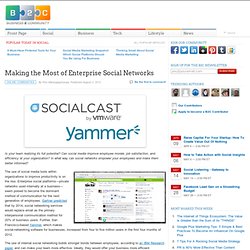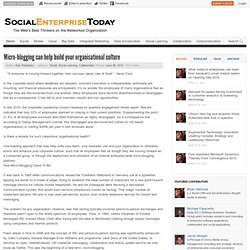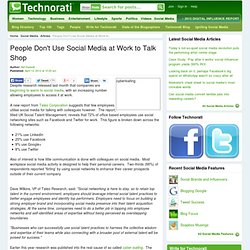

Six Ways to Use Social Media to Improve Internal Communication. It’s not just for customer acquisition and support anymore.

Social media is a great way to bring your organization closer together. It can be used for communication, collaboration, and meetings. It could save you money and time. What’s not to like about it? Steve Nichols recently outlined 10 ways to improve internal communications. Understand the company culture. Inexpensive social-media platforms make employee retention fun. Making the Most of Enterprise Social Networks. Is your team realizing its full potential?

Can social media improve employee morale, job satisfaction, and efficiency at your organization? In what way can social networks empower your employees and make them better informed? The use of social media tools within organizations to improve productivity is on the rise. Enterprise social platforms—private networks used internally at a business— seem poised to become the dominant method of communication for the next generation of employees. Gartner predicted that by 2014, social networking services would replace email as the primary interpersonal communication method for 20% of business users.
The use of internal social networking builds stronger bonds between employees, according to an IBM Research paper, and can make your team more effective. Maximizing collaboration is the fundamental value-add of any enterprise social network, and speed is the key provided by social networks. There is also the matter of ease-of-use. Using Social Media: Creating Podcasts For Your Employees. Earlier this week, I wrote 10 Easy Ways to Build Social Media Into Your HR Practice. Now I am sharing specifics on each of the ideas I suggested. These are written with beginners in mind.
Today, we’re going to learn how to create podcasts for your employees. There are so many employees who prefer a quick hit of information in verbal form. With hundreds of email coming in each day, key HR messages can tend to get buried and possibly never opened. Create podcasts for employees- What information do you share? HR is tasked with communicating throughout the year on a variety of topics. Leadership meetings and updatesAnnual benefit enrollmentPerformance review processMerit increase informationLocal office initiativesCharitable giving updates and opportunities How to get started Firs, have a conversation with your Marketing leader.
An Examination of How Social Media Is Embedded in Business Strategy and Operations Survey Findings. Why CEOs Should Allow Facebook in the Workplace [INFOGRAPHIC] Social Media Tools 4 Internal Communication by Ana ADI on Prezi. Putting Social HR in Its Place: the Employee Lifecycle. Micro-blogging can help build your organisational culture. “If everyone is moving forward together, then success takes care of itself.”

Henry Ford In the corporate world where deadlines are rampant, constant innovation is indispensable, workloads are mounting, and financial pressures are omnipresent, it’s no wonder the employees of many organisations feel as though they are disconnected from one another. Many employees have become disenfranchised or disengaged and as a consequence, it has led to poor business results and lost opportunities. In late 2010, the Corporate Leadership Council released its quarterly engagement trends report. Results indicated that only 22% of employees planned on staying in their current positions. Is there a remedy for such calamitous organisational health? The problem for any organisation, however, was that texting typically involved person-to-person exchanges and therefore wasn’t open to the entire spectrum of employees.
PC Magazine defines micro-blogging as follows: People Don't Use Social Media at Work to Talk Shop. Despite research released last month that companies are beginning to warm to social media, with an increasing number allowing employees to access it at work.

A new report from Taleo Corporation suggests that few employees utilise social media for talking with colleagues however. The report, titled UK Social Talent Management, reveals that 72% of office based employees use social networking sites such as Facebook and Twitter for work. This figure is broken down across the following networks: 21% use LinkedIn20% use Facebook9% use Google+8% use Twitter Also of interest is how little communication is done with colleagues on social media.
Dave Wilkins, VP of Taleo Research, said: "Social networking is here to stay, so to retain top talent in the current environment, employers should leverage internal social talent practices to better engage employees and identify top performers. Earlier this year research was published into the real cause of so called cyber loafing. How discussion forums can help internal communications « Mark Morrell Intranet Pioneer.
This is the last post in a series answering the question “Can collaboration tools improve internal communications?”

Covering the right culture needed within an organisation, the redefining of internal communicators’ role and how collaboration tools and features can help improve internal communications. I now want to discuss how I believe discussion forums can add to the richness of existing internal communication channels and not be a threat that needs to be closed down. I’m going to illustrate this with three examples. 1. Reacting to discussion forums The initial reason why most discussion forums first start is because employees want to, or organisations encourage employees to, share problems and solutions on work issues with other employees who can help or need the information. 2.
Internal communications can take a more pro-active role with discussion forums. 3. Consider having regular chats online with senior managers and employees. Like this: Like Loading...